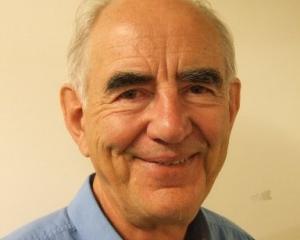The Collins Dictionary defines pariah as "a social outcast". As they huddle on streets outside our workplaces, on footpaths outside our hotels and restaurants, and by overflowing ashtrays near our hospitals, airport terminals and elsewhere, it must be hard for smokers not to feel that the descriptive noun was invented just for them.
And the tobacco net, it seems, is closing in. Playgrounds and parks in many parts of the country will likely soon join the list of places where smoking is banned. Most major sporting venues have already taken that step.
There is pressure for smoking to be banned in other outdoor areas, too - such as the possibility raised earlier this month of Dunedin City Council banning smoking on outdoor seating areas.
This week - just a month after it was announced in Budget 2012 that tobacco excise taxes would rise 10% a year on January 1 for the next four years - it has been suggested by health groups that duty-free tobacco allowances should be scrapped. They have also called for the price of cigarettes to rise 40% next year, followed by 20% in each of the three years after that. Public health specialist Dr Murray Laugesen estimates such price increases - through higher taxes - would prompt 100,000 smokers to quit and reduce consumption by one billion cigarettes next year.
Such attitudes towards smoking have not always been the case, of course. Until relatively recently, smoking was not only common, it was positively encouraged in many countries. Movie stars, sporting heroes and other "fashionables" glamourised the habit. Tobacco products were included as part of military rations. The "smoko" break meant just that. Advertisements were printed in newspapers and magazines with slogans such as: "More doctors smoke Camels than any other cigarette" and "L&M. Just what the doctor ordered".
Given what we now know about the harmful effects of smoking, such attitudes are hard to believe.
The evidence of harm from smoking is today beyond doubt. The "Smokefree" website of the Health Sponsorship Council - a New Zealand government agency - states tobacco is the single biggest cause of preventable death in New Zealand, with about 5000 New Zealanders dying each year as a result of smoking and exposure to second-hand smoke.
It says one in two smokers will die from smoking and "tobacco is the only consumer product that will kill half its users when used as intended".
It estimates people who die of a smoking-related disease lose, on average, 15 years of life. It says smoking increases the risk of developing stroke and heart disease, cancers of the lung, oral cavity, pharynx, larynx, oesophagus and pancreas and diseases of the urinary tract, pelvis, bladder and digestive tract; that it causes one in four of all cancer deaths in New Zealand; and is a major cause of blindness.
Despite the research, however, some people still choose to take up smoking (to do so defies logic, but sometimes that is the human condition). And because tobacco remains, at this stage at least, a legal product in New Zealand, there have been concerns expressed about personal freedoms and personal choice.
Some label the latest moves as being yet more evidence we live in a "nanny state".
As we wrote earlier this year, there is a fine line between prohibitions that seek to minimise harm and social and economic cost, and those which curtail individual freedom of choice. However, in the absence of a total ban on tobacco - which still seems some way off - increasing taxes and abolishing duty-free tobacco allowances seem sensible suggestions to help stub out smoking.
Yes, choosing to take up smoking is personal choice. But that argument is surely nullified by the fact smoking is addictive: many smokers (more than 80% by some estimates) now wish they had never started.
And if, as health officials believe, higher prices will lead to lower rates of smoking, there is little wonder why they are pushing for increased taxes - they want to save us from ourselves.
The growth of New Zealand's economy and the ability to offer more and better jobs comes from growing businesses, not halting agriculture, Federated Farmers national president Bruce Wills says.
In his address to the organisation's national conference yesterday, Mr Wills looked ahead to 2020 and predicted that by June that year, primary industry exports would well exceed $40 billion.
That would be a 25% increase over the next eight years but well below the almost 73% increase over the past eight years.
The combination of an indebted local market, as well as troubled European and American markets, would prove strong headwinds, but Asia would support much of the new growth, Mr Wills said.
There would also be some "slow down" due to environmental constraints but he hoped not too much.
Having recently returned from overseas, he got the impression that while the rest of the world was worrying how to feed a growing population, some in New Zealand were talking of capping production.
"While the rest of the world seems focused on growing their economies, some here talk of winding back the clock." New Zealand could not afford to lose another 53,000 people to Australia next year in a search for better jobs.
"We need to grasp new opportunities here," he said.
Agriculture has taken last place across all indexes in the latest National Bank business outlook. The fact that agriculture remained "the weakest link on just about every metric" was no real surprise given the highs it was coming off in terms of production and price, BNZ economist Craig Ebert said.
But every sector came down compared to the previous month's survey, especially manufacturing.
A net 13% expected business conditions to improve over the year ahead, down from a net 27% last month.
The good news was that sentiment was still positive and it was natural to feel a little more cautious heading into winter.
The bad news was that stripping out the mild seasonal pattern showed confidence was still down and had been declining since March, National Bank chief economist Cameron Bagrie said.
Firms remained optimistic regarding their own prospects, with a net 21% expecting an improvement over the year ahead. But that was "putting a very positive spin on it". It was down 14 points on the previous month, he said.
The ASB New Zealand commodity price index held relatively steady last week, ending just 0.3% lower.
Dairy prices were slightly lower but meat and forestry prices climbed in US dollar terms.
Silver Fern Farms' latest market update said beef markets globally continued to remain soft.
Chilled lamb demand was firm as New Zealand production volumes continued to decline.
Demand for frozen lamb remained slow.
Although demand remained positive for frozen venison, there was increasing resistance to chilled pricing for the forthcoming game season.






